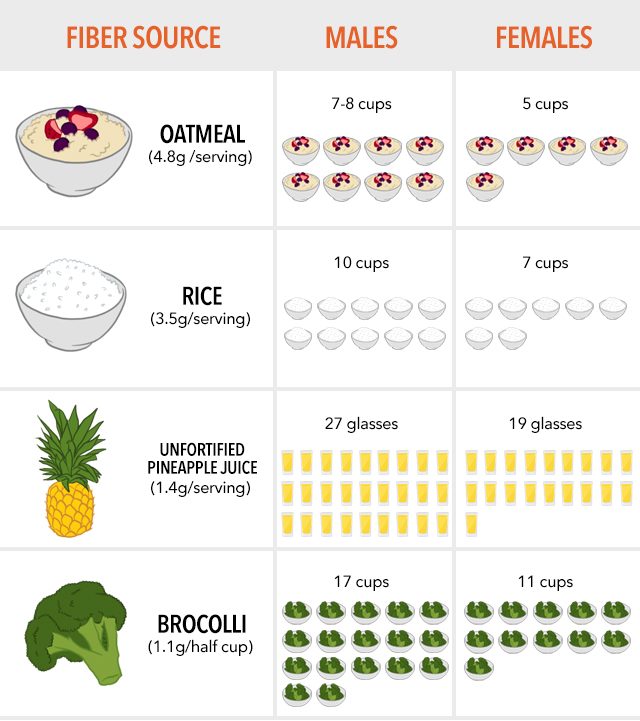SUMMARY
This is AI generated summarization, which may have errors. For context, always refer to the full article.

MANILA, Philippines – When choosing what to cook or what to order from the menu, do you think about how much fiber your plate will have? Probably not.
On discussions about healthy food choices, fiber isn’t usually brought up. What’s typically considered are the basic things: eat as many fruits and vegetables as possible; control portions; compliment everything with exercise. Most of the time, however, these are easier said than done. (Read: The ‘breakdown’ you need to stay healthy)
Yes, eating healthy requires an overall consideration of all the nutrients and minerals that are good for the body. But if you want to start being healthy now, paying attention to your fiber intake is a practical first step. Here’s why:
We’re living increasingly sedentary lifestyles
Physical movement is necessary to keep the digestive system functioning well. Unfortunately, most Filipino adults today live very busy yet non-active lifestyles, spending too much time at work or on the road, and not doing enough physical recreation or exercise. (Read: ‘Too busy’ to stay healthy? Read this)
According to Dr. Leonora Panlasigui of the Philippine Association of Nutrition, the combination of a sedentary lifestyle and poor diet choices is dangerous. “What we have now is a lot of eat-all-you-can, unlimited rice promos, and so on and so forth. You eat more than what you need,” she says. Combine a sedentary lifestyle with a love for rice, sisig, and other “guilty pleasures,” and you’ll always feel sluggish or heavy – even if your weight right now is well within your height and age range. And when you feel sluggish, exercise is the last thing you’d want to do. It can become a vicious cycle that can snowball to diseases like obesity and diabetes.
Helping your body cleanse itself so you can feel more energized and give your body the initiative to move more and start getting fit.

“Extra Rice” comes with extra consequences
According to the latest National Nutrition Survey data from the Department of Science and Technology’s Food and Nutrition Research Institute (DOST-FNRI), rice, fish and vegetables are the biggest components of a typical Filipino’s diet.
It sounds like a healthy plate, but closer analysis of the data reveals that our rice and starch consumption far outweighs our daily intake of fish, vegetables, fruits, and even meat. Along with high rice and cereals intake, our consumption of salt and oil are also increasing. While this means that we get a lot of energy, it also means that most Filipinos have higher blood sugar levels. The latest National Nutrition Survey data also notes an increasing trend in the prevalence of high blood sugar from 2003 (3.4%) to 2013 (5.4%) among Filipino adults. The incidence of obesity is also increasing – 3 out of 10 Filipinos are now obese or overweight. Filipinos with weight problems are at greater risk for complications like diabetes, heart disease, and colon cancer.
It does more than “clean up”
You probably know that fiber’s most important role in our body is aiding digestion. It helps our body get rid of excess waste by “sweeping” our intestines. But did you know that fiber is not just good for “cleaning up” our body? Published local studies associate an increase in dietary fiber intake with healthier blood sugar and cholesterol levels. The “lighter feeling” associated with improved digestion can also have a positive effect on your disposition and physical appearance.
Simply deciding to consume “known sources” of fiber isn’t enough. Based on the same FNRI data, our daily consumption of other food groups like fish, meat, fruits, and vegetables do not usually meet the national Recommended Energy and Nutrient Intake (RENI) levels, especially for fiber. For adult males it’s 38g while for females, it’s 25g. To visualize how much that amount looks like, check out this table of common fiber sources:

(Note: these values are presented for illustration purposes. They are not equivalent to a recommended intake amount to meet the daily fiber RENI levels. (Data source)
Clearly, it’s a challenge to meet the daily fiber requirement from just a few food sources. Eating more than two cups of rice, for example, is not recommended because too much of white rice can make your blood sugar levels go up.
So how can Filipinos start putting more fiber into their diets? Start with being more conscious about what you pile into your plate. “If you are aware of the effect of food on the body, then you have to exercise, you have to move. Diet and physical activity are important,” Panlasigui advises.
Aside from being more conscious about your diet and exercise routines, nutritionists like Panlasigui also recommend using fiber supplements to fill in the gap. These can greatly help in reducing the risks from bad food choices and help you manage your weight easier. Look for supplements that contain soluble fiber, such as Psyllium, to maximize the health benefits.
Bear in mind that increased fiber intake is not a be-all, end-all solution to your well-being. But it can be a pretty good start – a clean slate towards a healthier lifestyle. – Rappler.com
Add a comment
How does this make you feel?

There are no comments yet. Add your comment to start the conversation.